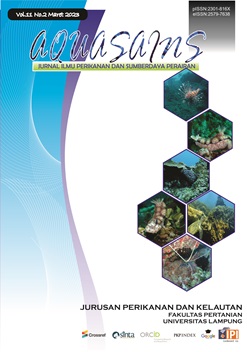ANALYSIS OF BACTERIAL ABUNDANCE IN THE INTESTINES OF COMMON CARP Cyprinus carpio TREATED WITH THE PROBIOTIC Bacillus subtilis
DOI:
https://doi.org/10.23960/aqs.v11i2.p1269%20-%201276 Abstract View: 268
Abstract View: 268
Abstract
Efforts to increase microbial populations in fish intestines tract can be done by utilizing microbes in the fish's digestive tract as probiotics. The application of Bacillus subtilis in fish feed mixtures can provide better growth performance in modifying microbes in the intestines of fish. The aim of this research was to analyze the bacterial community in the intestines of Common Carp(Cyprinus carpio) that have been given probiotics from the bacteria Bacillus subtilis with metagenome sequencing using 16S rRNA through Next Generation Sequencing (NGS) technology. Common carp samples were collected from maintenance conducted with different treatments, namely control fish without probiotic administration and fish treatment with mixed feed probiotic Bacillus subtilis. This research was conducted in the Laboratory of Fisheries Biotechnology, Faculty of Fisheries and Marine Science, Padjajaran University. Then molecular identification was carried out using Illumina's NGS in Novogene, Singapore. The results of the identification of using probiotic bacteria Bacillus subtilis in Common carp(Cyprinus carpio) feed affect the bacterial community in the fish intestine. In the intestines of carp that were given probiotics, the highest abundance was Proteobacteria, Fusobacteriota, and firmicutes.
The highest abundance at the genus level in both samples was domiciled by the genus Cetobacterium followed by the Sphingomonas and Aeromonas.Downloads
References
Aslamyah, S., Azis, H.Y., Sriwulan, dan Wiryawan, K.G. 2009. Mikroflora saluran pencernaan ikan gurame (Osphronemus gouramy Lacepede). Torani-Jurnal Ilmu Kelautan dan Perikanan, 19(1): 66 – 73.
Fuller, R. 1989. A Review: Probiotics in man and animals. Journal of Applied Bacteriology, 66: 365-378.
Joseph, S.W., A.M. Carnahan, P.R. Bryton, G.R. Fanning, R. Almazan, C. Drabick, E.W. Trudo dan R.R.Colwell. 1991. Aeromonas jandaei and Aeromonas veronii dual infection of a human wound following aquatic exposure. J. Clin. Microbiol. 29: 565-9.
Leys, N.M.E., Ryngaert, A., L. Bastiaens, Verstraete, W., E.M. Top, dan D. Springael. 2004. Occurrence and phylogenetic diversity of Sphingomonas strains in soil contaminated with polycyclic aromatic hydrocarbons. Applied and Environmental Microbiology. 70: 11944e11955.
Larsen, A.M., Mohammed, H. H., Arias, C.R. 2014. Characterization of the gut microbiota of three commercially valuable warm water fish species. Journal of Applied Microbiology. 116: 1396-1404.
Metzker, M. L. 2010. Sequencing technologies the next generation. Nature Reviews Genetics, 11(1), 31–46. doi: 10.1038/nrg2626.
Mulyani, Y., I. Aryantha, N.P., Suhandono, S., dan Pancoro, A. 2018. Intestinal bacteria of common carp (Cyprinus carpio L.) as a biological control agent for aeromonas. Journal of Pure and Applied Microbiology, 12(2), 601–610. Doi: 10.22207/JPAM.12.2.18
Mulyani, Y., A. Purwanto, dan Nurruhwati, I. 2011. Perbandingan Beberapa Metode Isolasi DNA untuk Deteksi Dini Koi Herpes Virus (KHV) pada Ikan Mas (Cyprinus carpio L.). Jurnal Akuatika.
Novogene. 2021. from https://en.novogene.com/services/research-services/metagenome-sequencing/16s-18s-its-amplicon-metagenomic-sequencing/.
Purwaningsih, I. 2013. Identifikasi Ektoparasit Protozoa pada Benih Ikan Mas (Cyprinus carpio Linnaeus. 1758) di Unit Kerja Budidaya Air Tawar (UKBAT) Cangkringan Sleman DIY. Skripsi. Program Studi Biologi Fakultas Sains dan Teknologi UIN Sunan Kalijaga Yogyakarta.
Rahmawan, M. E. A., Suminto, dan Herawati, V.E. 2017. Penggunaan Bakteri Kandidat Probiotik pada Pakan Buatan Terhadap Efisiensi Pakan, Pertumbuhan dan Kelulushidupan Lele Dumbo (Clarias gariepinus). Journal of Aquaculture Management and Technology, 3(4): 257–264.
Ray, A. K., Bairagi, A., Ghosh, K. S., dan Ken, S. K. 2007. Optimization of fermentation conditions for cellulase production by Bacillus subtilis CY5 and Bacillus circulans TP3 isolated from fish gut. Acta Ichthyologica et Piscatoria, 37(1): 47–53.
Sabbathini, G. C., Pujiyanto, S., Wijanarka., dan Lisdiyanti, P. 201. Isolasi dan Identifikasi Bakteri Genus Sphingomonas dari Daun Padi (Oryza sativa) di Area Pesawahan Cibinong. Jurnal Biologi. 6(1): 59-64.
Sambrook, J., Fritsch, E.F., dan Maniatis, T. 2001. Molecular cloning: a laboratory manual, 3rd ed. Cold Spring Harbor Laboratory, Cold Spring Harbor, N.Y.Kimia. 9(1): 117-123.
Sugita, H., C. Miyajima, dan Y. Deguchi. 1990. The Vitamin B12-Producing Ability of Intestinal Bacteria Isolated from Tilapia and Channel Catfish. NIPPON SUISAN GAKKAISHI. 56: 701-701.
Sullam, K.E., Essinger, S.D., Lozupone, C.A., O’Connor, M.P., Rosen, G.L., Knight, R., Kilham, S.S. el al. 2012. Environmental and ecological factors that shape the gut bacterial communities of fish: a meta-analysis. Molecular Ecology. 21(13), 3363-3378.
Susanti, I., Kusumangtyas, R.W., dan Illaningtyas, F. 2007. Uji Sifat Probiotik Bakteri Asam Laktat Sebagai Kandidat Bahan Pangan Fungsional. Teknologi Dan Industri Pangan, XVIII.
Syahputra, H., Bakti, D., dan Kurnia, M.R. 2014. Studi komposisi makanan ikan sepat rawa (Trichogaster trichopterus Pallas) di Rawa Tergenang Desa Marundal Kecamatan Patumbak. Aquacoastmarine, 5(4): 60-71
Tachibana, L., G. S. Telli, D. de. C. Dias, G. S. Gonçalves, M. C Guimarães, C. M. Ishikawa, R. B. Cavalcante, M.M. Natori, M. F. Fernandez Alarcon, S. Tapia-Paniagua, M. A. Moriñigo, F. J. Moyano, E. R. L de Araújo, dan M. J. T. Ranzani-Paiva. 2021. Bacillus subtilis and Bacillus licheniformis in diets for Nile tilapia (Oreochromis niloticus): Effects on growth performance, gut microbiota modulation, and innate immunology. Aquaculture Research, 52(4): 1630–1642. https://doi.org/10.1111/are.15016
Yogananth, N., R. Bhakyaraj, A. Chanthuru, T. Anbalagan, dan M. Nila. 2009. Detection of Virulence gene in Aeromonas hydrophila isolates from fish samples using PCR technique. Global Journal of Biotechnology and Biochemistry. 4(1): 51-53.

.png)










